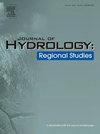Unrevealing the water-use strategies for typical ecological restoration plants and cash crops in the Eastern Chinese Loess Plateau region
IF 4.7
2区 地球科学
Q1 WATER RESOURCES
引用次数: 0
Abstract
Study region
Four geomorphic types in the eastern Loess Plateau (ECLP).
Study focus
quantitatively study the water-use strategies of typical plants (ecological restoration plants, food crops) based on stable isotope technology.
New hydrological insights for the region
Significant spatial-temporal heterogeneity appeared in regional soil water content and stable isotopes, with more significant fluctuations in soil water isotope values appearing in the rocky mountain region. Regional tree growth (including natural and plantation forests) was mainly influenced by precipitation (35±14 %) and surface layer (0–40 cm depth) soil water (25±11 %) during April and June, whereas deep soil water gradually became the main water source (> 20 %) in autumn and winter. A. Lavandulifolia mainly uses surface soil water (> 23 %), and the proportion of deep soil water utilization has increased after September. Surface soil water (0–40 cm) was the primary water source for T. aestivum during the overwintering (> 16 %) and reviving periods (> 26 %), and Z. mays utilized the largest proportion of soil water from 0 to 20 cm depth layer during the seeding (> 60 %) and maturation stages (> 35 %). Collectively, the results of this study have important implications for sustainable vegetation protection and the optimal allocation of water resources in the arid region.
揭示中国东部黄土高原地区典型生态恢复植物和经济作物的用水策略
研究区域黄土高原东部四个地貌类型。研究重点基于稳定同位素技术定量研究典型植物(生态恢复植物、粮食作物)的水分利用策略。 区域水文新认识区域土壤含水量和稳定同位素出现了显著的时空异质性,岩石山区土壤水同位素值波动更为显著。区域树木生长(包括天然林和人工林)在 4-6 月间主要受降水(35±14%)和表层(0-40 cm 深)土壤水(25±11%)的影响,而在秋冬季土壤深层水逐渐成为主要水源(> 20%)。A. Lavandulifolia主要利用表层土壤水(> 23 %),9月后利用深层土壤水的比例有所增加。越冬期(> 16 %)和恢复期(> 26 %),表层土壤水(0-40 cm)是 T. aestivum 的主要水源;播种期(> 60 %)和成熟期(> 35 %),Z. mays 对 0 至 20 cm 深层土壤水的利用比例最大。总之,这项研究的结果对干旱地区的可持续植被保护和水资源优化配置具有重要意义。
本文章由计算机程序翻译,如有差异,请以英文原文为准。
求助全文
约1分钟内获得全文
求助全文
来源期刊

Journal of Hydrology-Regional Studies
Earth and Planetary Sciences-Earth and Planetary Sciences (miscellaneous)
CiteScore
6.70
自引率
8.50%
发文量
284
审稿时长
60 days
期刊介绍:
Journal of Hydrology: Regional Studies publishes original research papers enhancing the science of hydrology and aiming at region-specific problems, past and future conditions, analysis, review and solutions. The journal particularly welcomes research papers that deliver new insights into region-specific hydrological processes and responses to changing conditions, as well as contributions that incorporate interdisciplinarity and translational science.
 求助内容:
求助内容: 应助结果提醒方式:
应助结果提醒方式:


